Santiago de Compostela is a feast for the senses. As Galicia’s capital, and major pilgrimage site since the medieval era, the city is now a juxtaposition of traditional and modern culture, architecture and gastronomy. Santiago de Compostela’s historic district has proudly earned the title of a UNESCO World Heritage Site, and is perhaps the most beautiful old town in all of Galicia. Cobblestone streets weave through the different plazas, all converging at the city’s most significant and emblematic structure, the Cathedral of Santiago de Compostela.
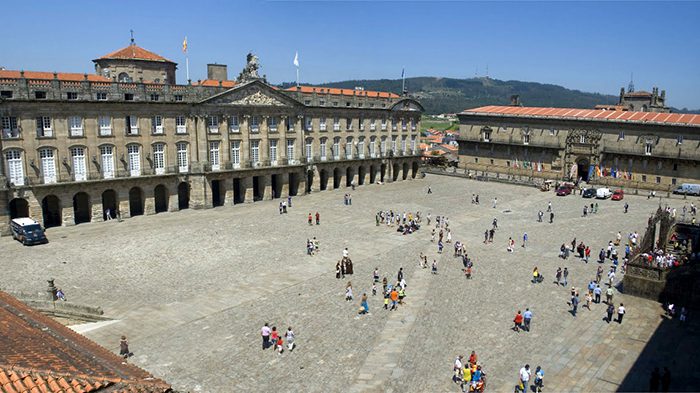
Romanesque, baroque, romantic and modern buildings comprise the urban landscape. Walking is the best way to explore all the sights and sounds of the city. Your tour of the city will reveal charming squares, pilgrims from all corners of the world and incredible Galician eateries. You will get the chance to experience the birthplace of a unique culture and witness a living history.
Scalloped shells are etched and painted in hundreds of conspicuous spots throughout the city, which is a testament to the centuries-old pilgrimage that has shaped Santiago de Compostela. Just as the cathedral is a sanctuary for the faithful, the city itself is a refuge from the uninspiring monotony of other European cities. Since the 1960’s, there has been a steady influx of university students from throughout Galicia.
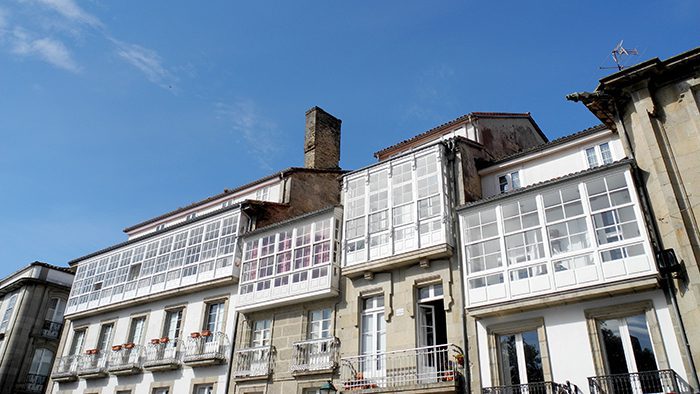
Their presence fuels the city’s gastronomic, hospitality and nightlife spheres, making this destination a unique mix of medieval and modern. Santiago de Compostela is the icing on any authentic Galician adventure. Here are our top 7 thing’s to do in Santiago de Compostela, Spain!
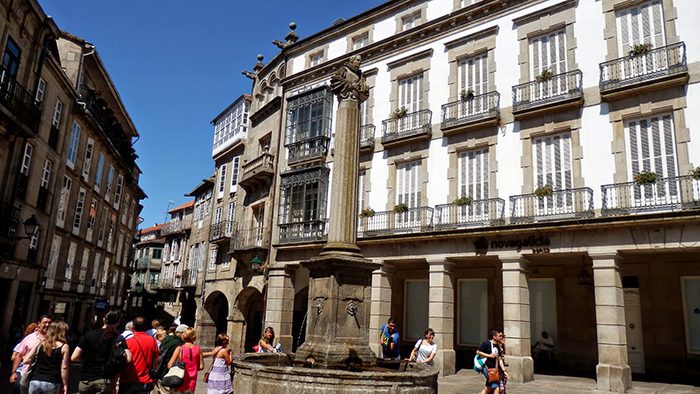
The Cathedral of Santiago de Compostela is the crown jewel of the city and one of Spain’s biggest attractions. The cathedral, shaped in the form of a Latin cross, was built over the final resting place of the Apostle Saint James. As it exists today, the cathedral is an array of architectural styles and add-ons made during the 9th through 18th centuries. The structure was destroyed by invading Moors in the year 997, but had its grandeur restored and now stands as one of Europe’s finest Romanesque-style buildings. The western façade, or the obradoiro façade, reveals 243-foot tall (74 m) towers, large windows and a sizeable representation of St. James dressed in pilgrim attire.
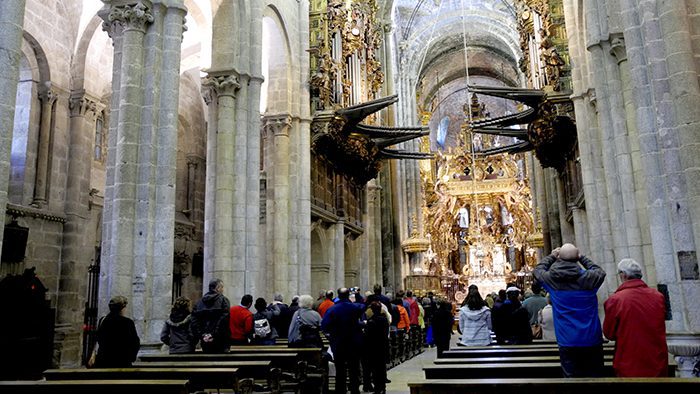
A dramatic split staircase leads to the entrance of the cathedral. Inside is the iconic 12th century Pórtico de la Gloria. The portico has three arches for each nave of the church. Its central arch has a figure of St. James. Its jambs (columns) have elaborate depictions; the left-hand side has prophets, with the most notable being Daniel; and the right-hand side features the apostles Peter, Paul and John.
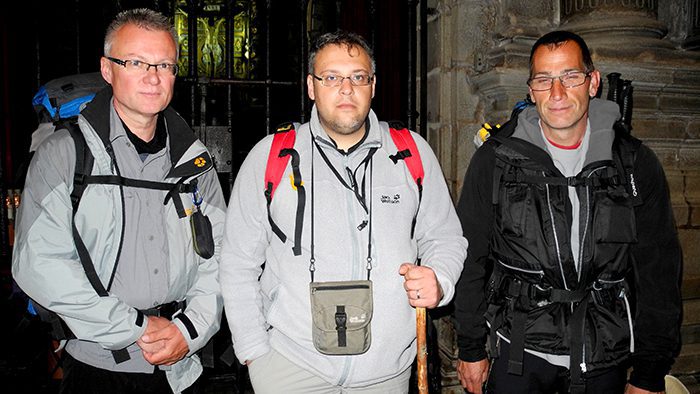
Inside, visitors can tour the high altar and four of the 16 chapels. To see more of the cathedral including its gothic cloisters, visitors must pay a €5 admission fee to enter the Cathedral Museum. This fee also covers access to various other sections of the cathedral including the crypt of the Pórtico de la Gloria, the Chapel of Relics and Treasury, Sacred Art Exhibit and gothic cloisters. Visitors who pay the fee will also gain access to a balcony overlooking Praza do Obradoiro. Finally, visitors can visit the shrine of the Apostle St. James.
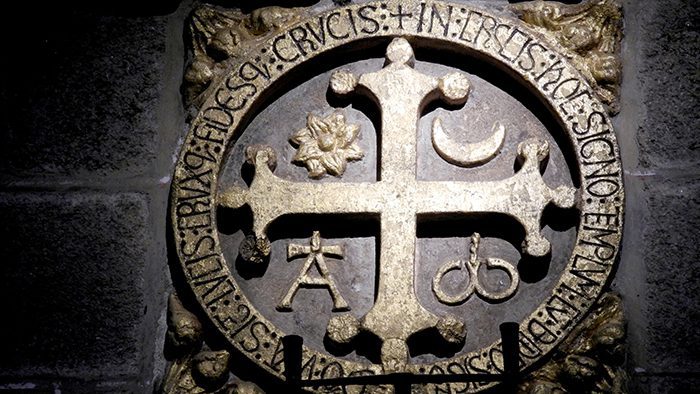
A mid day mass is held here daily in honor of the pilgrims who recently arrived. Those who register get their names read aloud by the priest during this ritualistic event. The congregation is purified with botafumeiros, or gilded incense burners. These traditional burners are swung around the congregation to bless it and fill the cathedral with perfumed air. Attending a mass is a truly unforgettable experience, no matter your religion. But it is especially heartwarming for the pilgrims who traveled long and hard to get there.
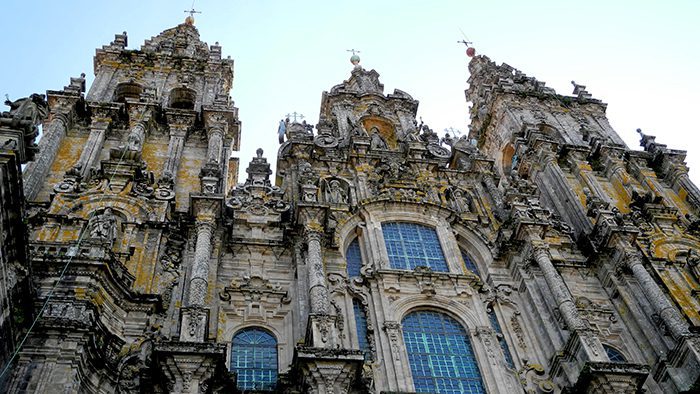
The Cathedral Museum is open October through May from 10 a.m. to 1:30 p.m. and from 4 p.m. to 6:30 p.m. Monday through Saturday and from 10 a.m. to 1:30 p.m. on Sundays and holidays. Admission for pilgrims and students is €3.
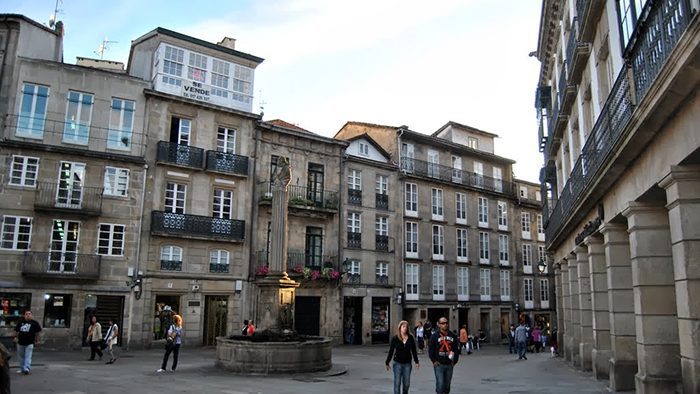
This square, named after Spanish novelist and author of Don Quixote, has a dark past. During the 12th century, this square was home to the city’s main marketplace, or campo. Praza de Cervantes is dominated by a 16th century baroque building. It served as the official town hall for 200 years, and now is the only intact municipal building of its kind in Galicia. Restorations of the building revealed that its interior was a medieval house of horrors. The lower levels of the building were used as dungeons to hold heretics and people suspected of blasphemy during the dark days of the Spanish Inquisition (1480-1834).
Check out What to See and Eat in Ourense, Spain

But outside in Praza de Cervantes is where the real terror took place. Auto-de-fe, or public penance, was a common form of punishment for victims of the Inquisition. It usually involved a trial, public judgment, torture and burning at the stake. The square used to have a rollo, or column, where prisoners were tortured before being killed. The gallows were located nearby, but were eventually dismantled and removed. Thankfully, nowadays, Praza de Cervantes is a pleasant square in the old town. It has a fountain dedicated to Miguel de Cervantes, and leads to other old town sights including the Church of San Martiño Pinario and the Convent of San Francisco.
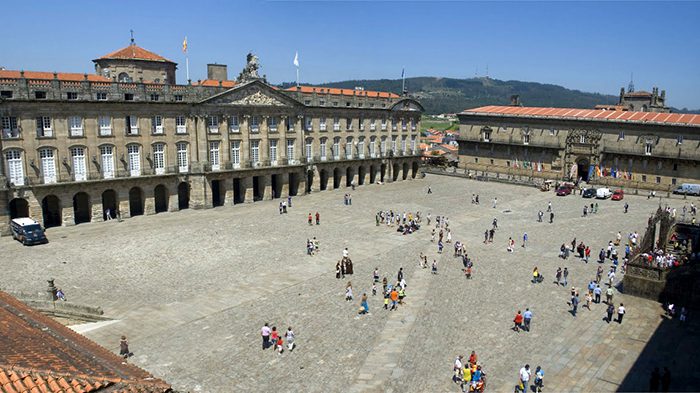
No grand cathedral is complete without a monumental plaza surrounding it. Praza de Obradoiro is just that – an elegant and expansive square that has been receiving pilgrims since the 12th century. Several important buildings flank the square, with the cathedral being the grandest. The Hostal de los Reyes Católicos, which was constructed in 1501 and used as a pilgrim hospital, is now a parador, or government-owned luxury hotel. The Saint Jerome College now serves as offices for the university. Finally, there is the Palacio de Raxio, or the City Council Administration, which sits directly across the plaza from the cathedral.
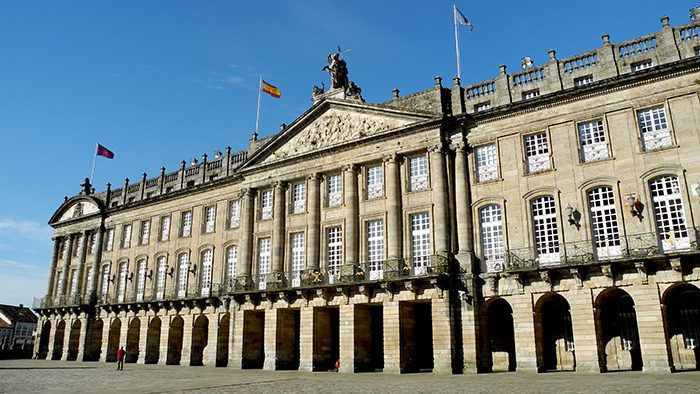
Each day, Praza de Obradoiro is bustling with activity. Administrative, religious and academic affairs are carried out here. All the while, pilgrims from everywhere are arriving around the clock. Many bask in the sunlight in the center of the square for some time, while others head inside the cathedral to pray. The center of Praza do Obradoiro is considered to be “kilometer zero” of every Camino de Santiago route. There is a granite slab in the middle of the square commemorating the 1987 declaration by the Council of Europe that says the Camino de Santiago is the “First European Cultural Itinerary.”
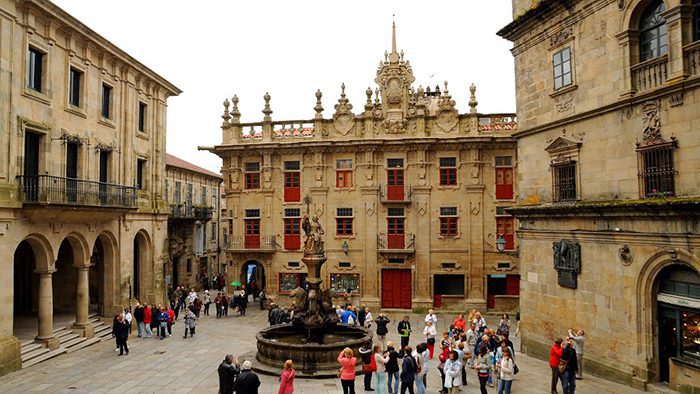
Praza das Praterías, or Silversmith’s Square, is quite possibly one of the city’s most elaborate squares. Named after the silver workshops of the middle ages, Praza das Praterías’ architectural features include a clock tower, the 19th century Fuente de los Caballos, or Fountain of the Horses, and the northern façade of the cathedral. This Romanesque façade, known as the Puerta del Paraíso, is highly ornate with several friezes of angels, apostles and symbols of the zodiac.
Check out the 10 Things to See and Do in Burgos

Upon close inspection, several biblical stories emerge from the carvings including the creation story and Jesus Christ’s Passion (Judas’ betrayal and Pontius Pilate’s judgment). Each figure has a distinct facial expression and body position, which makes the wall seem to come alive. A cloister wall also frames Praza das Praterías. It too has biblical scenes including a depiction of Mary and the baby Jesus.
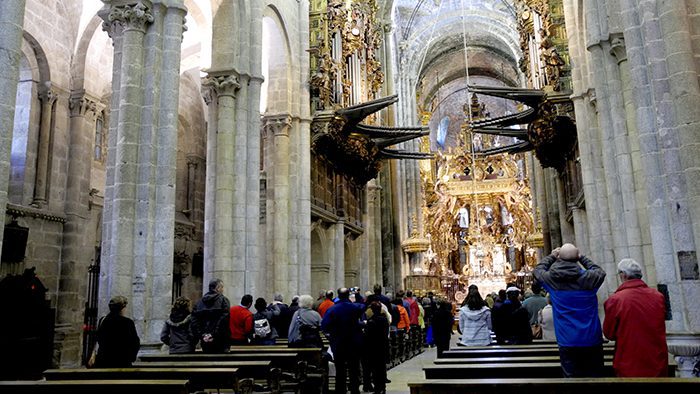
Mercado de Abastos is an indoor market and one of the city’s top attractions, second only to the Cathedral. Since 1873, market vendors have been peddling produce, meats, cheeses, fish, poultry and house wares at this indoor gastronomic paradise. Local vendors carefully select, butcher and package their products for all who come through in search of authentic Galician ingredients. The Mercado de Abastos is open Monday to Saturday 7 a.m. to 3 p.m. Come early to avoid the late morning rush from 11 a.m. to noon.

The Museo do Pobo Galego, or Museum of the Galician People, is a wonderful way to acquaint yourself with Galician culture and history. Open since 1977, the museum’s galleries display numerous objects from all over Galicia including traditional clothing, folk music recordings, paintings, religious art and sculptures. But perhaps the most splendid of its exhibits is the museum’s collection of industrial instruments from coastal and rural areas. Antique sail boats, fishing line spools and handmade hooks teach visitors about Galicia’s maritime traditions. Sickles, ox carts and milk jugs showcase what a typical agricultural life entailed.
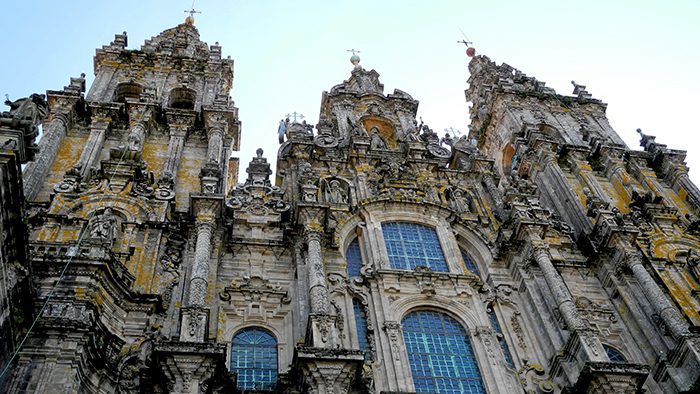
Every gallery speaks of a different aspect of Galician past and present. If you are not familiar with Galician history, this is a vital stop on your travels through Santiago de Compostela. The museum is housed within the 13th century San Domingos Convent. The Museum of the Galician People is open Tuesday to Saturday 10 a.m. to 2 p.m. and from 4 p.m. to 8 p.m; Sunday 10 a.m. to 2 p.m.; closed on Mondays. Admission is €3.

In honor of the thousands of peregrinos, or pilgrims, that traveled to this city, the Pilgrimage Museum (Museo das Peregrinacións de Santiago) was officially established in 1996. It is often referred to as the Gothic House because it is located within a gothic building near other old town sights. It was created to compliment the city’s other attractions and educate visitors about the centuries of pilgrimages completed here.
Check out What to See in Lugo, Spain

The Pilgrimage Museum houses a priceless collection of religious art from the cathedral, as well as gifts from private collectors. Its eight rooms showcase the origins of the pilgrimage, iconography of St. James and craft traditions of the city. The museum also has a library containing over 8,000 texts pertaining to a variety of subjects such as Galician literature, Christianity and history. The Pilgrimage Museum is open Tuesday to Friday 10 a.m. to 8 p.m.; Saturday 10:30 a.m. to 1:30 p.m. and from 5 p.m. to 8 p.m.; Sunday 10:30 a.m. to 1:30 p.m.; closed on Mondays. Admission is free.
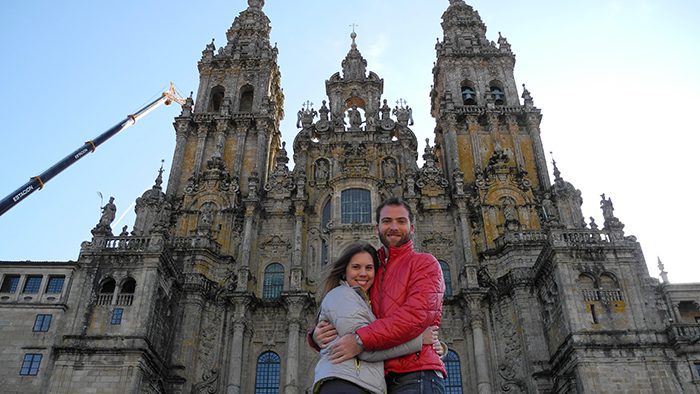
I rarely get the chance to experience such a charismatic and historical old town like Santiago de Compostela’s. The mix of students, locals, tourists and pilgrims is truly unique, giving the city a flair unlike any other city in Galicia. As Galicia’s capital, there is a rich culture in Santiago de Compostela. While it is a place of commerce, it has a long history of being a meeting point for people from all walks of life and all corners of the world. Don’t miss the chance to see the pilgrims who arrive here daily. A mass is held for them everyday at noon in the cathedral. Try to stop at Praza de Obradoiro more than once to get good shots of the cathedral. Unfortunately, the plaza is packed with people at all hours of the day, but if you try more than once you will most likely get the stunning photo you came for. I managed to get mine with a tripod I set up in the middle of the plaza. I stood in awe of the cathedral’s grandeur for several minutes before entering.
In terms of dining, be prepared to wean yourself off an early eating schedule. This was probably one of the hardest adjustments I had to make in Galicia. People eat late, and I mean very late for American standards. Lunch is typically at 2 p.m. and dinner at 9 p.m. to 9:30 p.m. Once you finish up your late night meal, go out. Santiago de Compostela is the perfect walking city, so it’s easy to bar hop safely before walking back to the hotel. And you will be in good company too; university students take breaks from studying to hit up the local watering holes.
Santiago de Compostela is not only Galicia’s crown jewel; it is one of Spain’s national treasures. The sights, the tastes and the historical significance of the city make it one of western Europe’s most fascinating places.
Time zone: GMT +1
Getting around: Walking is the best way to take in the city, but there is also a pubic bus, plenty of taxis and bicycle rentals (see below).
Shopping: Shopping choices cater to the eclectic mix of students, pilgrims, tourists, ex-pats and locals that work and play in this distinct city. The old town is dotted with silver shops containing everything from small charms to large and ornate reproductions of the cathedral. The outdoor “hippie market” on Rua Nova sells costume jewelry and other handmade accessories. It is open daily from 10 a.m. to 8:30 p.m. A typical dessert to buy in the old town is the Tarta de Santiago, a traditional crumb cake bearing a symbol of the cross in powdered sugar. It is typically eaten with coffee.
Fashionistas head to the Ensanche quarter (Roxa Plaza, Xeneral Pardiñas, Galicia Plaza, Doutor Teixero, Rupública del Salvador, República de Arxentina and Montero Ríos Streets) where the city’s upscale boutiques are located. Área Central mall is a large commercial complex located in the As Fontiñas neighborhood. Here you will find a cinema, a variety of restaurants and all the big Spanish brands like Zara, Bershka and Massimo Dutti. For those who crave a different kind of shopping experience, there is an antique market held every Saturday morning under the arches of the postal building on Travesía de Fonseca Street.
Nightlife: The historical center is packed with cafés, pubs and bars, while the newer part of the city houses the nightclubs and dance venues (the Roxa Plaza area, República de Arxentina, Santiago del Estero, Santiago de Chile and Calle Nova de Abaixo Streets).
Currency: Euro.
Currency converter: XE
Best time to go: May to October. The weather can be unpredictable all year round, so pack an umbrella, rain boots and a coat.
Did you enjoy our article of 7 things to do in Santiago de Compostela, Spain? Leave us a question or comment below!
Counter
101 Countries • 1432 Cities
Mariz says:
Dear David,
I enjoyed reading your article and it is very helpful in my travel in Santiago next month.
Thank you.
Best Regards.
Mariz
Fabiola says:
Awesome information. I plan to be in Santiago de Compostela the last week of July. This will be my first time in Spain and I randomly picked this city. I am glad I came across your site and found great info and tips.